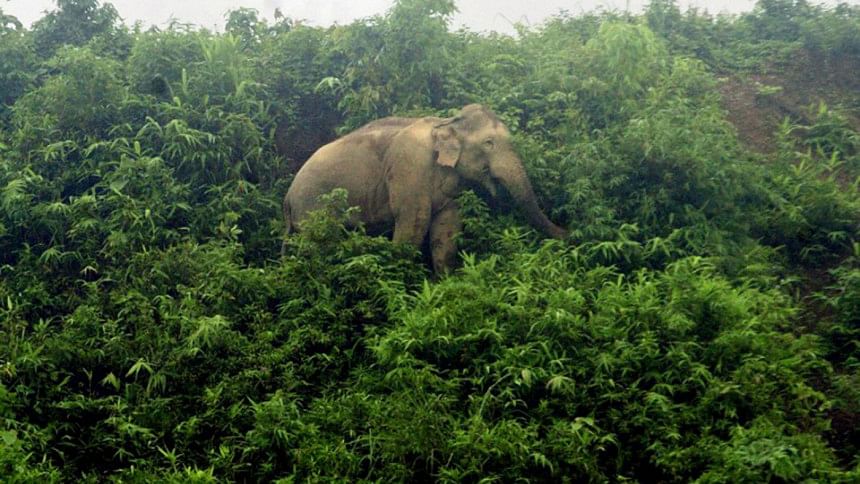Development work leading to frequent elephant attacks in Ctg villages

Parveen Akther (45), a resident of Joistopura village under Boalkhali upazila in Chattogram, used to hardly experience elephant attacks. The fear of elephant attack has never been a part of daily life for her. But in the last five or six years, a herd of elephants have regularly scoured their village in search of food, in the process attacking people and damaging crops.
Now the constant fear of elephant attacks have gripped not only her but the whole village.
On November 24, at least three people died in an elephant attack at Kodurkhil, a neighbouring village. Another person died in December in a similar kind of attack in Joistapura.
Parveen told The Daily Star that they never saw such frequent attacks before. They fear when stepping out in the evenings, as darkness makes it tough to locate a charging elephant's position.
Thousands of people are spending sleepless nights in various parts of six upazilas in Chattogram due to sharp increase in elephant attacks. At least ten people died in multiple attacks in the last four months at Rangunia, Boalkhali, Anwara, Bashkhali, Lohagora and Satkania upazila.
According to the forest department, at least 88 elephants died from 2001 to 2019 in Cox's Bazar, Chattogam and three districts of the Hill Tracts combined. Around 50 people died in elephant attacks from 2010 to 2019.
Md Kamal Uddin (40), a resident of Sharaf Bhata union under Rangunia upazila, told The Daily Star that he did not see such frequent attacks even five years back.
"Every now and then, elephants attack our village and damage crops and claim people's lives," he said. An elderly person died in his village in January this year in elephant attack.
Abu Naser Md Yeasin Neyaz, divisional forest officer (nature conservation and wildlife) of Chattogram, told The Daily Star that they formed nine elephant response teams comprising of ten members each in the wake of repeated attacks.
The committee is actively working now at Anwara, Bashkhali and parts of Chakaria upazila, he said, adding that they will form at least 30 such committees to reduce human-elephant conflict.
"Elephant response teams firstly try to understand the behaviour of elephants and then try to move them back to the forest, depending on their behavioral trend. The second task is to keep curious people outside of the range of elephants, so that no fatalities take place," he said.
Md Raquibul Amin, country director of International Union of Conservation of Nature (IUCN), told The Daily Star the extent of attacks have seen a sharp rise in recent years as forest area reduced and the elephants lost access to food.
Elephants hardly marauded across Rangunia and Anwara upazilas before, but in recent days elephant attacks in those areas became a common phenomenon, he said. It was necessary to look for the reason seriously, the IUCN country director added.
"Elephants need large habitats. As connectivity between habitats are shrinking due to various development work, they have few spaces left to roam, forcing them to swoop in on localities. Our development work must be elephant and wildlife friendly", he said.
IUCN classified the Asian Elephant as an endangered species, with a population of 268 at present in Bangladesh.
Elephant expert AHM Raihan Sarker, associate professor of Institute of Forestry and Environmental Science at Chittagong University, told The Daily Star that the habitats of elephants are getting destroyed in the name of development. Authorities often spurn the opinions of relevant experts in development planning, in the process costing forest areas and wildlife.
The correct methods of protecting forests are not followed properly, and results in people encroaching on forest land and shrinking the habitats of herbivores like elephants. Forest land is being leased out to many influential people in the locality, thus constricting the roaming space for elephants, he further added.
"We see the reluctance of policy makers in most of the cases when it comes to the conservation of nature and its wildlife. The politicians are not conscious enough. Those who advise them about development projects have their own interests. These are the bitter truth. That's why the issue of conserving nature does not get reflected in developing planning", he added.

 For all latest news, follow The Daily Star's Google News channel.
For all latest news, follow The Daily Star's Google News channel. 



Comments